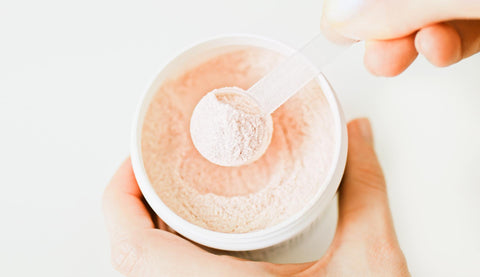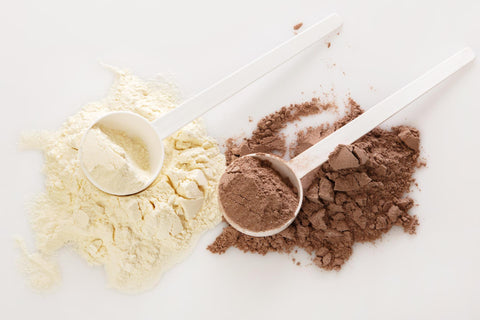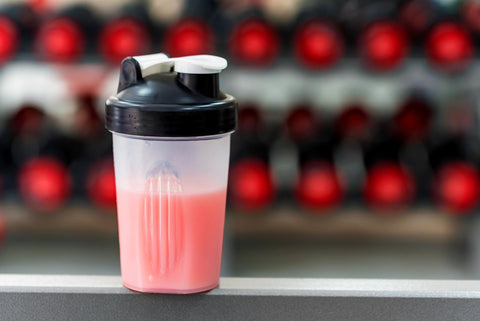How is Protein Powder Made? A Comprehensive Guide
Have you ever asked yourself the question: how is protein powder made? Over recent years, protein powder has become a mainstream health product. It has made its way from niche health stores into the kitchens of fitness-conscious folk everywhere. If you're an athlete or just someone seeking to balance your nutrition, understanding the journey of protein powder from raw ingredients to the finished product can be helpful when making informed decisions on what's right for you. To learn more about the manufacturing process of your favourite protein powder, this article has got you covered. Let's begin!
Understanding Different Protein Powders
Essential for muscle recovery and growth, immune health and just about everything else, protein is a macronutrient that's beneficial for everyone (not just gym-goers). However, for various reasons, some people find it hard to hit their required protein intake, partly because protein powders have exploded into mainstream health and wellness culture. Once reserved for bodybuilders, protein powders have gained popularity as a convenient way to boost protein intake.
Before delving into its production, it's crucial to understand what different protein powders are available on the market. There are various types, each with unique properties and popularity depending on the consumer. Whey, casein, hemp, soy, and pea protein are common sources derived from milk, hemp hearts, soybeans, and peas. Their amino acid profile and digestibility differ, catering to different dietary needs and preferences. Let's take a look at some of the most common types of protein powders you can buy.
Whey Protein Isolate (WPI)
Whey protein isolate is arguably the most popular type of protein powder supplement. The bioavailable amino acids, including branched-chain amino acids crucial for muscle building and repair, make this protein powder particularly favoured by athletes. The high levels of protein make it an excellent choice for post-workout recovery. This form of whey protein is processed to remove most fat and lactose, resulting in a purer protein product, usually containing 90% or more protein by weight. Whey protein isolate is easily digestible, which means it's less likely to cause gastrointestinal discomfort than other protein sources. It can be a suitable option for individuals with mild lactose intolerance.
Whey Protein Concentrate
In contrast to whey protein isolate, whey protein concentrate is a less processed form of whey that contains natural nutrients found in whole whey. It typically has a lower protein content, ranging from 70% to 85% by weight and higher levels of fats and lactose. This means it retains more of the beneficial immunoglobulins and lactoferrins, which are believed to support immune function and gut health. Whey protein concentrate still offers a high-quality protein source that can support muscle growth and repair, but it may be less suitable for those with significant lactose intolerance. Its slightly sweeter flavour and richer texture make it particularly appealing for use in shakes, bars, and other food products where texture and taste are important.
Pea Protein Powder
Pea protein powder has emerged as a formidable plant-based alternative that caters to the needs of vegetarians, vegans, and those with dairy allergies or sensitivities. Extracted from yellow split peas, this protein powder is prized for its high protein content and amino acid profile. The hypoallergenic nature of pea protein makes it a preferred option for those with dietary restrictions. The environmental impact is significantly lower than animal-based proteins, which might be relevant if you align with environmentally conscious values. Pea protein powder's versatility allows it to be easily incorporated into various recipes, offering a nutritional boost without compromising flavour.

Soy Protein Powder
Soy protein powder has been around for decades and is a plant-based product valued by vegans and vegetarians. Derived from defatted soybean flakes, it's an excellent source of high-quality protein that includes all nine essential amino acids, making it a complete protein. This characteristic is essential for those who do not consume animal products. Soy protein powder also comes with the benefits of naturally occurring isoflavones, which may have positive health implications, including reducing the risk of heart disease. With its mild flavour and versatility, soy protein powder can easily be incorporated into various meals and snacks, ranging from smoothies to baked goods.
Hemp Protein Powder
Hemp protein powder is a popular choice for those looking to increase their daily protein intake while incorporating other essential nutrients into their diet. This plant-based protein powder is made from ground hemp seeds and has an impressive nutrient profile that includes omega-3 and omega-6 fatty acids, fibre, and minerals such as iron, zinc, B vitamins and magnesium. These additional nutrients make it a nutritious option for vegans and vegetarians, who may have difficulty obtaining these essential nutrients from other sources. Hemp protein powder has a slightly nutty taste, making it an ideal addition to smoothies, energy balls, and pancake batter.
The Manufacturing Process
The creation of protein powder is a complex but fascinating process. It involves several steps, each critical to producing a high-quality product that delivers on its nutritional promises.
Sourcing of Raw Materials
The first stage of production is the sourcing of raw materials. Different protein sources require various cultivation and harvesting methods to ensure the highest quality. For instance, whey protein is a byproduct of cheese production, while soy protein often starts with non-GMO soybean crops. Pea and hemp protein powders are sourced from split peas and hemp hearts.
Extraction and Purification
Once the raw materials are collected, the protein is extracted through several mechanical and chemical processes like filtration and pH adjustment. For whey and casein, this starts with liquid separation from milk. In the case of soy and pea protein, the focus is on isolating the protein from the plant material.
Filtration and Drying Techniques
It is filtered using membrane and ion exchange techniques to isolate the protein further. These methods help remove lactose, fat, and carbohydrates, leaving a more concentrated protein source. After filtration, the protein solution is dried using spray drying to turn it into a desiccated or powdered form.
Flavouring and Sweetening
Raw protein powder may not be palatable, so many manufacturers add flavours and sweeteners. This stage is crucial for consumer satisfaction and can involve using natural or artificial ingredients to create a wide array of taste options. If you're sensitive to additives or other excipients, reading the ingredients label carefully is always best.
Packaging, Labelling and Quality Control
Once the protein powder is flavoured and sweetened, it undergoes rigorous quality control checks. When it comes to protein powder, quality and safety are non-negotiable. The production process should adhere to strict industry standards to keep the final product safe for consumption.
Compliance with labelling regulations is particularly important so that you are aware of what you're consuming. Protein powders can sometimes contain allergens like milk, soy, and gluten. Proper labelling is critical to inform consumers of potential allergens and help individuals with dietary restrictions make informed choices.
Finally, the protein powder is packaged and sealed in containers designed to preserve its freshness and nutritional value.

The Benefits of Protein Powders
Protein powders can help you achieve your fitness and health goals when incorporated into a balanced diet. Put simply, they offer a quick and convenient way to meet your protein requirements. Protein powders are particularly beneficial for athletes and people who exercise regularly, providing the essential amino acids needed for muscle repair and growth.
Incorporating protein powder into the diet can aid in exercise recovery, be a valuable asset in chemotherapy recuperation, support weight management by increasing satiety, and even improve muscle protein synthesis rates when consumed post-workout. What's more, for people following vegetarian or vegan diets, protein powder can be an invaluable source of high-quality protein that might be harder to obtain from whole foods alone.
Choosing the Right Protein Powder
With so many options available, it can take time to choose the right one. Understanding your needs and goals is the first step in making a selection.
Factors to Consider
- Dietary restrictions
- Flavour and texture
- Cost
- Added ingredients
Dietary Restrictions
Vegans may opt for plant-based proteins such as soy, hemp, or pea. If you are lactose intolerant, you should avoid whey protein concentrate. If you want a highly digestible form, whey protein isolate is ideal.
Flavour and Texture
Many flavour options are available, from vanilla and chocolate to more unique ones like salted caramel. If you're using protein powder in shakes or smoothies, this factor might be worth taking into account.
In terms of texture, pea protein tends to be grainy and doesn't always mix well in shakes or smoothies, whereas a WPI or hemp protein powder may be a better option for a cleaner taste and texture.
Cost
While protein powders can be a cost-effective way to supplement your diet with additional protein, some brands may be more expensive than others. Consider your budget and compare prices and ingredients before making a purchase.
Added Ingredients
Don't skip the label. Look for the source of protein and the presence of any artificial additives. The ingredient list can give you a good idea of what's inside the pack and help you make an informed decision.

How To Use Protein Powders
Protein powder is incredibly versatile and can be incorporated into your diet in numerous ways. You can get creative with protein powders, combining good nutrition with fun in the kitchen. Whether it’s a simple shake or a baked dessert, there are several ways to include protein powders into your diet.
Recommended Serving Sizes and Timing
Consuming the right amount of protein at the appropriate times can enhance its benefits. For most, the general guideline is 30 grams per serving, with one serving post-workout for muscle recovery.
Creative Ways to Incorporate Protein Powder into Everyday Meals
- Morning Boost: Add a scoop to your oatmeal or pancake batter for a protein-rich breakfast.
- Smoothie Upgrade: Blend into smoothies with fruits, veggies, and a healthy fat source like nut butter or avocado.
- Baking Secret: Mix into muffins, cookies, or bread recipes for a nutritious twist on baked goods.
- Energy Bites: Combine with oats, honey, and your choice of mix-ins like coconut flakes or chocolate chips for easy-to-make protein balls.
- Coffee Companion: Whisk collagen powder into your coffee or hot chocolate for a satisfying, protein-packed drink.
- Healthy Snack Dip: Blend into Greek yogurt or hummus for a more robust macronutrient profile.
- Dessert Delight: Fold into pudding or homemade ice cream bases for a treat that satisfies your sweet tooth and protein needs.
Conclusion
Now you can answer the question - how is protein powder made? Understanding this topic means appreciating the science, skill and expertise put into a product designed to support your health. Whether you're looking to boost your protein intake after a workout, support your skin and immune health or augment your already-balanced diet, protein powders are a great way to get the job done. Blend them into a shake or bake them into a dessert; let your choice of protein powder be as mindful as the rest of your nutrition journey.
Article References
Calbet, J. A., & MacLean, D. A. (2002). Plasma glucagon and insulin responses depend on the rate of appearance of amino acids after ingestion of different protein solutions in humans. The Journal of nutrition, 132(8), 2174–2182. https://doi.org/10.1093/jn/132.8.2174
Carunchia Whetstine, M. E., Croissant, A. E., & Drake, M. A. (2005). Characterization of dried whey protein concentrate and isolate flavor. Journal of dairy science, 88(11), 3826–3839. https://doi.org/10.3168/jds.S0022-0302(05)73068-X
El-Sayed, M. M., & Chase, H. A. (2011). Trends in whey protein fractionation. Biotechnology letters, 33(8), 1501–1511. https://doi.org/10.1007/s10529-011-0594-8
Hasegawa, Y., Ijichi, H., Saito, K., Ishigaki, K., Takami, M., Sekine, R., Usami, S., Nakai, Y., Koike, K., & Kubota, N. (2021). Protein intake after the initiation of chemotherapy is an independent prognostic factor for overall survival in patients with unresectable pancreatic cancer: A prospective cohort study. Clinical nutrition (Edinburgh, Scotland), 40(7), 4792–4798. https://doi.org/10.1016/j.clnu.2021.06.011
Kerksick, C. M., Jagim, A., Hagele, A., & Jäger, R. (2021). Plant Proteins and Exercise: What Role Can Plant Proteins Have in Promoting Adaptations to Exercise?. Nutrients, 13(6), 1962. https://doi.org/10.3390/nu13061962
Saxton, R., & McDougal, O. M. (2021). Whey Protein Powder Analysis by Mid-Infrared Spectroscopy. Foods (Basel, Switzerland), 10(5), 1033. https://doi.org/10.3390/foods10051033
Morr, C. V., & Ha, E. Y. (1993). Whey protein concentrates and isolates: processing and functional properties. Critical reviews in food science and nutrition, 33(6), 431–476. https://doi.org/10.1080/10408399309527643

